by Heather Plett | Oct 23, 2013 | Uncategorized
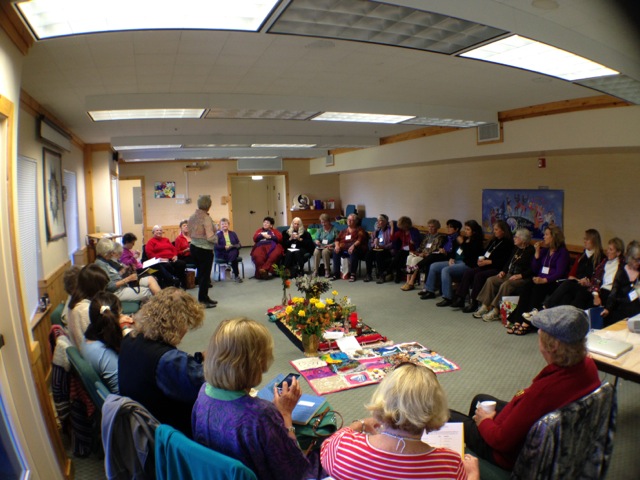 In the past week, I have done three interviews – two where I was guest speaker for online courses and one where I was a guest on an upcoming telesummit on feminine wisdom.
In the past week, I have done three interviews – two where I was guest speaker for online courses and one where I was a guest on an upcoming telesummit on feminine wisdom.
The theme that kept coming up in all three of those conversations, and in my recent talk at Patti Digh’s Design Your Life Camp, was this:
We don’t need another hero. (Thank you, Tina Turner.) What we need instead are people who will serve as hosts.
This is not an original thought to me, but the more I learn about it, the more central it has become to the work that I do. (I learned it first from my teachers Margaret Wheatley and Deborah Frieze, and have become immersed in it in my work with The Art of Hosting and Harvesting Conversations that Matter.)
We have built too many of our models (in business, government, church, Hollywood, etc.) on the expectation that someone will show up as the hero to save us from the ills of the world, or that we have to show up as the hero for someone else. What that does is create environments where our heroes have too much power, we assume that the rest of us don’t have the capacity to impact real change, and we become complacent in the face of violence, destruction of the earth, racism, economic imbalance, etc.
Here’s what Meg Wheatley has to say about the difference between a hero and a host:
You’re acting as a hero when you believe that if you just work harder, you’ll fix things; that if you just get smarter or learn a new technique, you’ll be able to solve problems for others. You’re acting as a hero if you take on more and more projects and causes and have less time for relationships. You’re playing the hero if you believe that you can save the situation, the person, the world.
Hosting Leaders create substantive change by relying on everyone’s creativity, commitment, and generosity. They learn from firsthand experience that these qualities are present in just about everyone and in every organization. They extend sincere invitations, ask good questions, and have the courage to support risk-taking and experimentation.
The more I learn about what it means to serve as a host leader, the more I am determined to incorporate it into every part of my life. I am a host leader in the way that I teach at the university, inviting my students into their own creativity, innovation, and way of learning instead of trying to impose my ideas on them. I am a host leader in the way I lead retreats, starting always in circle, where we look into each other’s eyes, see the humanity there, and share our stories in a way that invites both vulnerability and strength to show up. I am a host leader in the way that I parent, creating a container for my children to grow into the best version of themselves, instead of trying to mould them into my view of what they should be. I am a host leader in the way I coach, asking meaningful questions that will reveal my clients’ deepest wisdom and truth.
How can we be more intentional about serving as host leaders? Here are some of the thoughts that have emerged from my many conversations with my teachers and fellow-learners on the subject:
- Start with curiosity. Leaders are usually taught to be decisive and knowledgeable, and to “never let them see you sweat”. That’s a hero model that closes the door to new things showing up and to other people bringing ideas and questions into the room. Instead, open the door to possibility by being curious. What is opening up? What is possible? What do people bring? What would happen if…?
- Host yourself first. Get clear on who you are and where you stand. Find the practices that help to ground you in your own truth and wisdom and that help you withstand the pressures of ego and “the way things have always been”. Inquire into your own stories, triggers, and fears first so that you are more prepared to host what shows up in the circle. (A practice like Mandala Discovery can help with that.)
- Be vulnerable. Admit what you don’t know. Admit that you need other people. Admit your failings. It may seem counterintuitive, but vulnerability is one of the greatest strengths of a leader. Vulnerability invites courage, growth, and meaningful relationships.
- Invite vulnerability in others. Create a space where it is safe to fail, to fall apart, to not know the answer, and to take risks. People will show up with all of who they are when they know that they are safe.
- Trust other people and invite them to bring their creativity, commitment, and wisdom. Every time I teach, I begin by saying “I am not the only person who brought wisdom into the room. Everyone of you brought wisdom, and it is my hope that at some point in this class, you will feel comfortable enough to share it.” Trust them and give them autonomy.
- Ask good questions that open up meaningful conversations. Good questions are invitational rather than assuming. They invite energy rather than trying to contain it. They serve like a garden hoe, loosening the soil so that the seeds can grow.
- Be an active and engaged listener. An effective host leader spends a lot of time in silence. That’s something that’s taken me a lot of time to learn as a leader/teacher/parent – that I am more effective when I am listening to other people than when I am trying to fill the space with the knowledge I feel compelled to offer people. An effective listener/host allows the people in the circle to get closer to their OWN wisdom and stories rather than trying to adopt someone else’s wisdom.
- Start with a “heart at peace” rather than a “heart at war” (from the book Anatomy of Peace). A heart at war sees others as objects to be overcome, colonized, monopolized, directed, changed, while a heart at peace sees the humanity in each person.
- Rearrange the chairs. Most of our classrooms, boardrooms, conferences rooms, etc., are set up in a way that honours the hero model, with the expert at the front of the room. As my circle teachers, Christina Baldwin and Ann Linnea say, “change the chairs and you change the conversation.” Get people into circle and teach them that each person in that circle has some responsibility for holding the container and for honouring every other person in the room. There is no room for a hero leader in a circle.
If this is something you’d like to learn more about, I invite you to attend the upcoming Art of Hosting training that I’ll be co-hosting in Winnipeg in November. This is the kind of training that I wish everyone could take at some point in their life. The more of us who take it, the more the world will change.
by Heather Plett | Aug 15, 2013 | art, Beauty, circle, Community, grace, Spirituality
I am home after nearly two weeks of journeying across the prairies. It was amazing. I am replenished, encouraged, and feeling full of the goodness of this earth and the people on it.
I am still on a bit of a high and not entirely sure that I have the right words to articulate what this journey meant for me, but I’m going to try anyway, before it slips too far into the past and is lost in a sea of other stories that want to be told.
Part 1: Journey to myself
“In solitude, at last, we’re able to let God define us the way we are always supposed to be defined—by relationship: the I-thou relationship, in relation to a Presence that demands nothing of us but presence itself. Not performance but presence.” – Richard Rohr
Though I could have easily gotten to Calgary with one long day of driving (and have done it many times), I chose to make the trip in two days so that I could savour the trip and enjoy a night of camping by myself. As Richard Rohr writes in Falling Upward, the older I get and the more I learn to love and understand myself, the more I enjoy my own company.
From the moment I left the city limits, I knew there was going to be something special about this journey. It was a stunningly beautiful day, with the kind of fluffy, storybook clouds artists and photographers pine for. It was also the perfect season, when there are still rich summer greens mixed with subtle autumn golds, browns and reds. The canola and flax are in full bloom, the wheat and barley fields are readying themselves for harvest, the round bales are beginning to be laid out across golden hay fields, and the calves born in early summer are strong, virile, and rambunctious.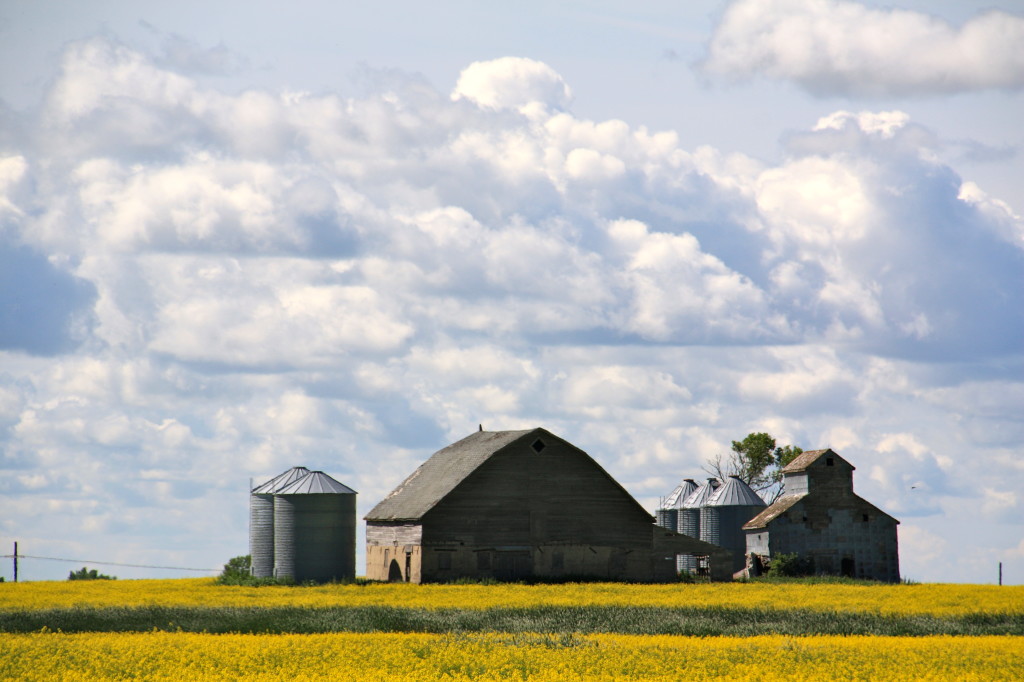
Everywhere I looked, the prairies seemed to be laying out their finery for me. I couldn’t resist stopping for photos of bright red barns set against bold blue skies, fields where flax flowers flowed like the waves on a peaceful sea, and ditches where butterflies and dragonflies danced from wildflower to wildflower.
When I pulled into Regina, I stopped for a bottle of wine and a cheap plastic wine glass (to enhance the picnic I’d brought from home) and headed to my campsite by a lake. The first thing I spotted at the campsite was a shiny loonie (dollar) on the ground – like someone had left it as a good luck charm.
Pushing through a broad strip of clover that stood higher than my head and smelled of heaven, I came to the lake. There in front of me, for no reason I could ascertain, was a picnic table half submerged in water. I waded out to the table and sat on it for awhile, snapping photos of fishermen, seagulls and rocks. The sun was about two hours from sunset, as far as I could tell, but I didn’t want to miss a moment of its setting. So I brought my picnic lunch and journal to the table and spent the next two hours on my little wooden island in the lake, hidden from view from most people by the huge stand of clover along the shore.
Those two hours were magical. My senses were heightened after a day full of prairie beauty, and every angle, every bit of light, every shadow, every rock, every bird, every line, and every reflection was drenched in beauty. For two hours I sat in awe, watching the light change on the lake and the clouds glow in the sky. God’s presence was palpable. It was one of those thin places that the Celts talk about, where heaven and earth collide.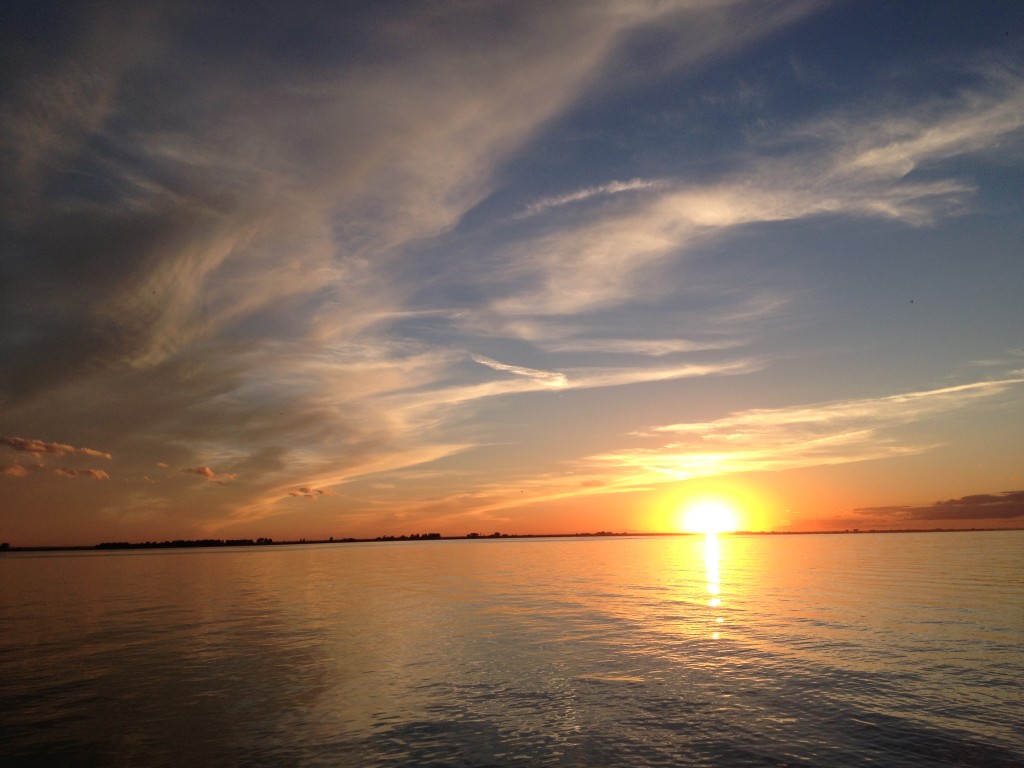
After the sun set, and night began to drift across the lake, I lit a fire at my campsite and had another magical hour of capturing light of a different kind – orange, glowing, flickering, pushing against the darkness. From the largeness of the sunset sky to the smallness of my cast iron fire pit – I was mesmerized by light.
The next day was much like the one before, with equally piercing blue skies and impossibly white clouds. I wandered on the beach, took pictures of more birds, feathers, and rocks, and then started the drive to Calgary. At one point, a storm rolled in, and the clouds changed to dark and dramatic. After two days of beauty, I wasn’t surprised to see a rainbow show up.
By the end of the day, I felt like I had just been courted by a devoted lover who was doing everything s/he could to make me feel special. In the words of Richard Rohr in the quote above, I was very much in “the I-thou relationship, in relation to a Presence that demands nothing of us but presence itself.” I found God on the prairies and God laid out the finest that the prairies had to offer to make sure I felt loved.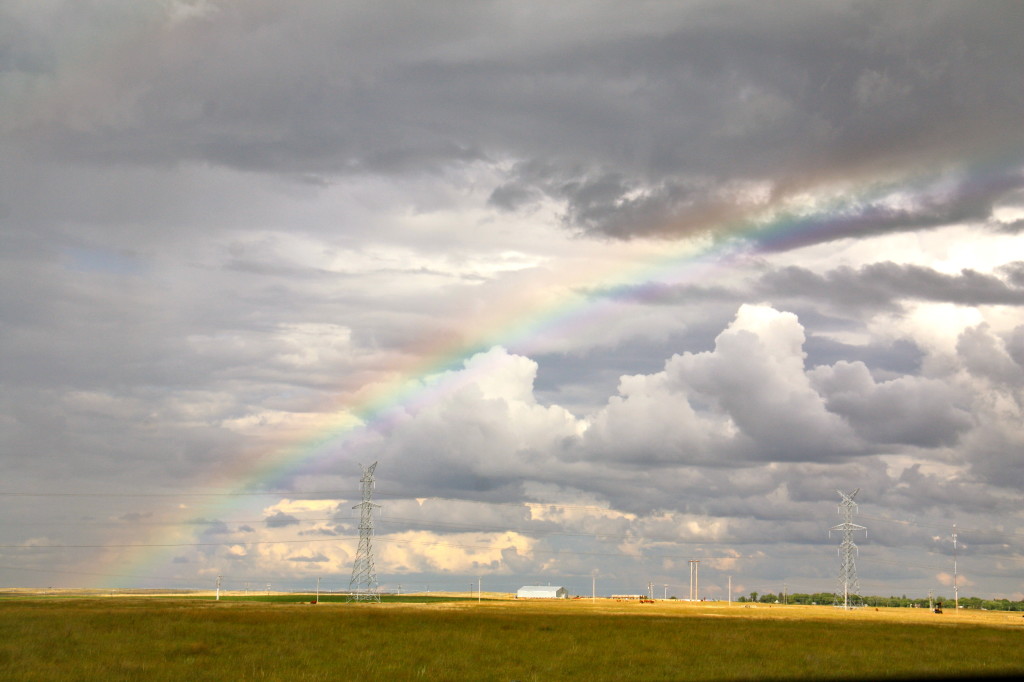
For more photos of my prairie journey, here’s a little video I put together.
Part 2: Journey to my family
“Always remember, there was nothing worth sharing
Like the love that let us share our name.” – The Avett Brothers
The purpose for my trip to Calgary was to visit my oldest brother, Brad, who’d been diagnosed with cancer a few weeks earlier and had had a three foot section of his colon removed the week before. When I’d heard about his cancer, I’d felt an intense need to spend time with him, and so I took advantage of the opportunity. It’s been a hard year for our family, after losing Mom to cancer in November, so the bond between us feels especially important.
If you met my big brother, you might marvel at the many ways that our world views are different, and – on the surface level – you might even question how we find common ground. His politics lean further right than mine do, he’d rather spend the afternoon in a hockey rink while I’d choose an art studio, and he doesn’t see the point in much of the self-discovery or community-building reading and writing I do while I’d be bored to tears with the kind of detail-oriented computer coding he does. (It almost seems like a cliche that he has a degree in math and I have a degree in literature.)
And yet… if you looked at only those things, you’d be missing a lot. For one thing, there’s something about 47 years of shared history, stories, jokes, faith, questions, and grief that creates a common language that few people in the world can understand. There is great safety and comfort in that common language, especially after you’ve lost a few of the only people on earth who know it. When you are in a place where you can speak that language and ask those questions without fear of judgement, it is worth more than gold.
And there’s another thing… unleash us in the mountains, on the prairies, or by the seashore with our cameras, and both of us can wander happily for hours. (Or – in the case this week – lament the fact that we can’t wander for hours due to a recently broken foot and major surgery.) And then we can sit together on the couch for another couple of hours going through the pictures to find the few in which we’ve captured the light just right.
In those things, there is plenty of common ground to make a trip across two provinces after a cancer scare an indescribably worthwhile thing to do.
I didn’t know how this visit would go, and frankly, I was a little worried to see what cancer was doing to my normally energetic and adventurous brother. On top of that, my sister-in-law (whom I also love dearly, and would easily cross two provinces for as well), has been dealing with some pretty heavy things this year, and my teenage niece has had an interesting recent time of learning more about her identity as well.
I expected their home to be full of turmoil and sadness… and yet… it wasn’t. There was a surprising amount of peace and grace in their home, not to mention a whole lot of love. My brother has a remarkable capacity for accepting life as it is and enjoying every moment that he can, and my sister-in-love has a remarkable capacity for making meaning of what is and articulating it in a way that shines new light into it. Plus they both have a deep faith that sustains them and gives them hope.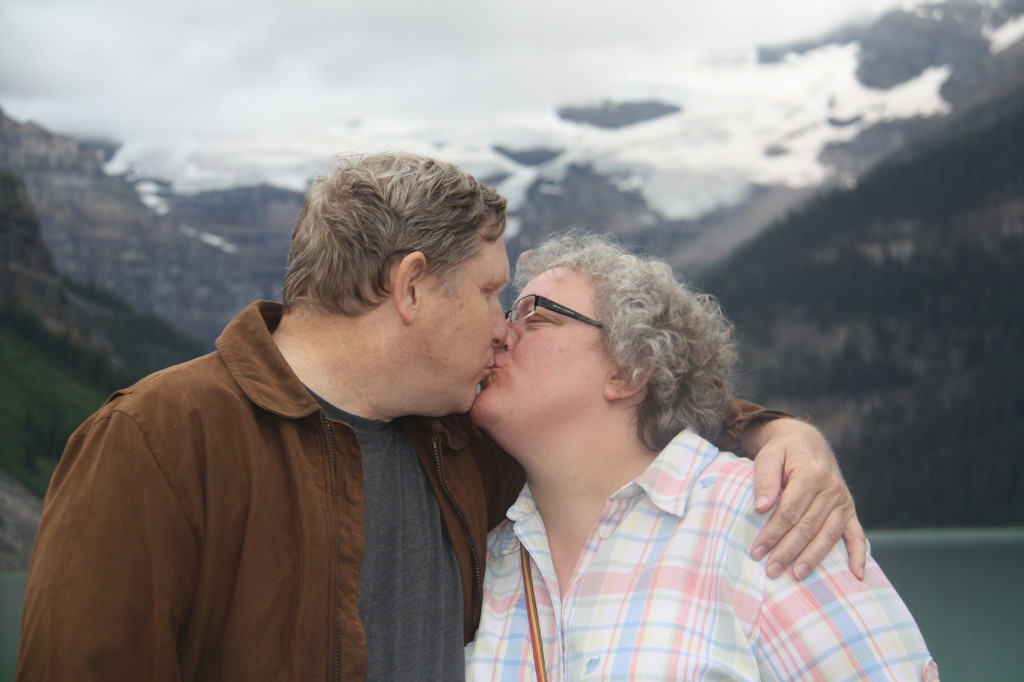
One of the most poignant moments of the visit was when I stood next to my brother in church (yes, he’s stubborn enough to go to church two days after being released from the hospital) and sang “Come Thou Fount”, a song that has a rich history in our family and was sung at both of our parents’ funerals. “Here I raise mine Ebenezer; hither by thy help I’m come; and I hope, by thy good pleasure, safely to arrive at home.” The Bible verse that those lines are inspired by was made into a wall hanging for Mom and Dad’s 25th anniversary, and hung in their home for twenty-three years after that until Dad died and the farm was sold.
Another poignant moment was standing at the shores of Lake Louise on a drive into the mountains. My recently broken foot and his surgery wounds meant that we couldn’t walk far, but it felt like a moment of grace to be able to stand there with him and Sue, enjoying the beauty around us. We are all broken people, heading inevitably to our deaths, and yet there are moments of beauty, grace, and light, and for that we carry on in this journey.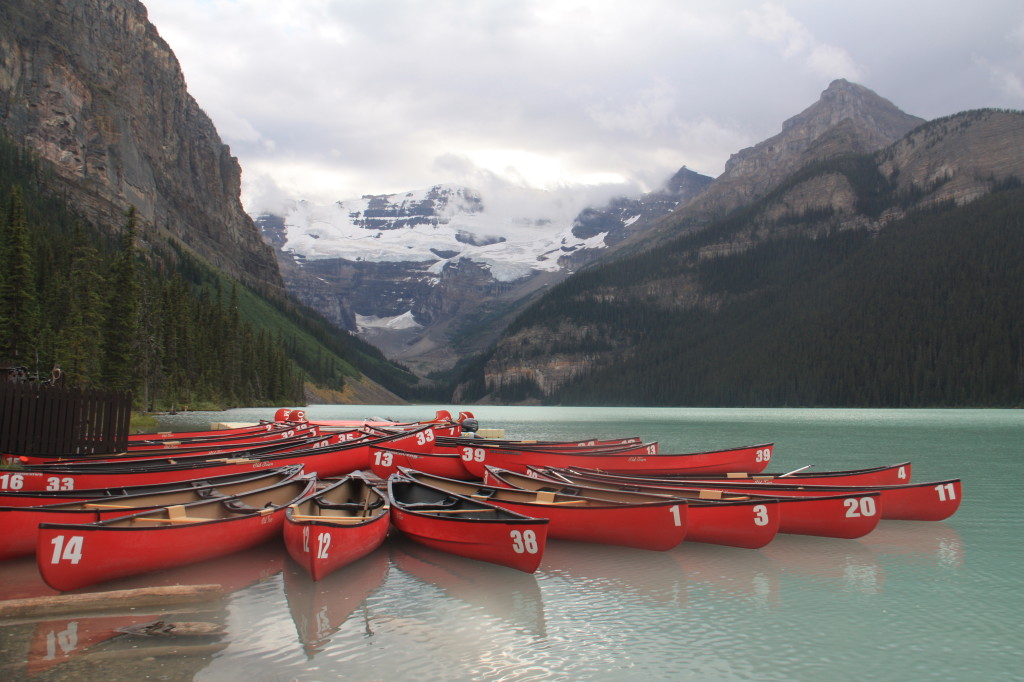
Part 3: The journey to others
“In helping others, we shall help ourselves, for whatever good we give out completes the circle and comes back to us.” ~ Flora Edwards
The final destination on this journey was a small prairie town, perched on the border between Saskatchewan and North Dakota, that looked a lot like the prairie town I grew up in. In North Portal, people trust each other enough to not only leave their doors unlocked but to leave the border unlocked. When you go golfing, you start out in one country and end in another, and they trust you to leave the parking lot through the same entrance (Canadian or American) that you entered through – no passport required. There used to be churches on either side of the border, but when their numbers dwindled, they joined and now meet in the new Canadian church in winter and in the older American church in summer.
In that town, there is an old school building that looks a lot like the place I spent the first nine years of my school life. There are not enough kids in town to fill it anymore, so they started bussing the kids to another town and sold the building to one of the townsfolk who put a friendly neighbourhood bar in one classroom and rents the other classrooms out to artists, healers, and others who need space.
In that building, Visions Art Guild holds their annual retreat. It’s a blissful week of summer camp for artists, with the local church ladies catering their meals, and everyone pitching in to do the dishes and keep the place clean. During the day, they make lots of art, have occasional inspirational sessions, and encourage each others’ creativity. In the evenings, they drink wine, make a little more art if they feel like it, and have a few good belly laughs (especially on the night of Frida Fest, when everyone dresses as their favourite Frida Kahlo painting or photo).
Every second year, they bring in a facilitator to inspire them in some area of growth. This year I was that lucky facilitator. On the theme of journey, I was invited to do three full sessions (a couple of hours each), three mini-sessions (about 45 minutes each), and one-on-one coaching sessions for anyone who wanted them (nine sessions). In between I got to make my own art and wander from station to station being inspired by the different styles and different mediums. Some worked in acrylics, watercolour, and oil, one added tiny twirly stitches to art prints, one did beautiful beadwork, one made fanciful beings out of found objects, one played with adding fabric prints of her prairie photos to her loomed rugs, one incorporated hand-dyed paper with natural objects, and one worked on a complex mixed media collage backdrop for her fanciful raven drawings. I dabbled with acrylics, watercolours, and mandalas, and took a lot of photos.
At the beginning of our week together, one of the retreatants helped me make a labyrinth in the grass, and that became the foundation of our exploration into the theme of journey. On the second day, I read Dr. Seuss’ “Oh the Places You’ll Go”, made road signs for the twelve places in the journey from the book (the prickly perch, the waiting place, etc.), and added those to the labyrinth. In addition, I’d collaged the words they’d sent me in response to some advance journal prompts onto a long piece of paper that represented the journey we were on for the week, and that piece of paper became a group art project that we added to throughout the week. We also made prayer flags to represent the things we most want to invite into our lives, our art, and our relationships.
What can I say about that week? For starters, it was SO MUCH FUN! Hanging out with artists and being inspired by their creative techniques and their capacity to see beauty made my own artist heart soar. For another thing, it was SO RELAXING! Yes, I was facilitating and coaching, but there was just so little pressure and the women in the group were delightful to work with and host in circle. They were receptive and responsive to my questions, they jumped into my activities with their whole hearts, and they embraced me as one of their own. And for another thing, it was very, very FULFILLING. In the coaching conversations, when I saw their faces soften with some new wisdom that was growing in them, and in the circle when I saw them opening themselves to new stories that will help them walk in the world with new courage, I knew that God was working through me to create safe space for their authenticity to show up.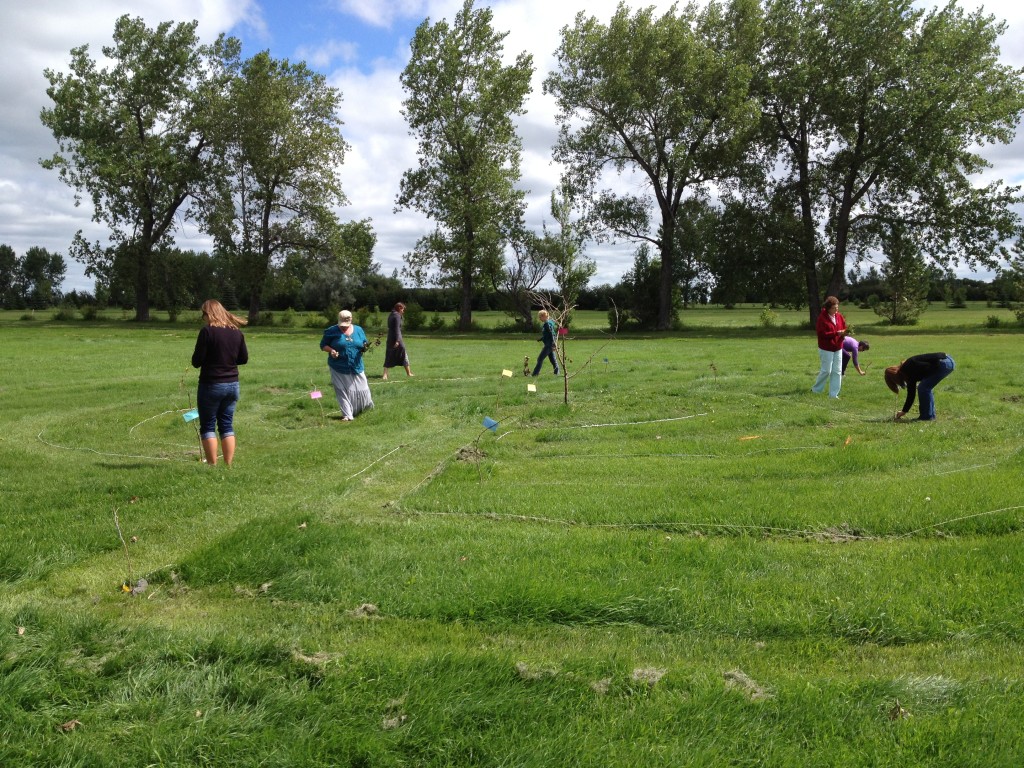
This is my absolute favourite kind of work – gathering women in circle and fostering their growth, creativity, and leadership. This is the kind of work that feels so much like play I almost feel guilty when they pay me at the end of the week.
I left that little prairie border town feeling like I was floating on a cloud. That beautiful circle of women gifted me with more than I could have possibly gifted them. They gave me tangible gifts (shoes, jewelry, a hand-woven rug, artist trading cards, and more), but the intangible gifts were far greater. They gave me love, acceptance, inspiration, and trust.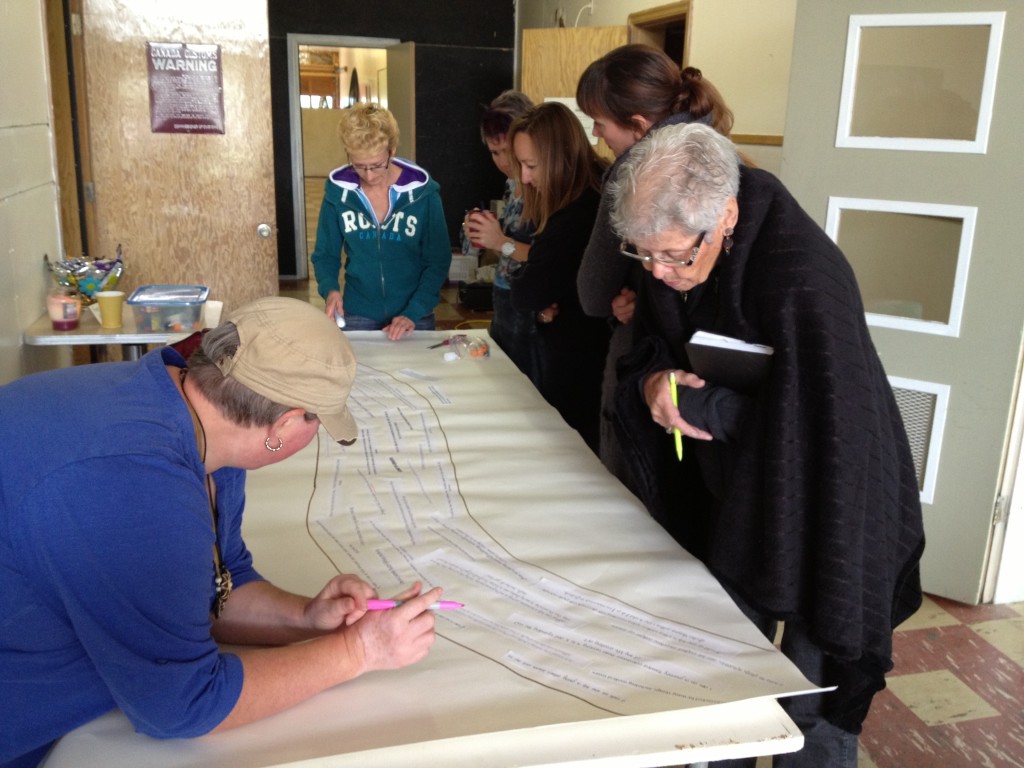
Part 4: The scary part of the journey that reminds me of the value of all the rest
“If you live to be a hundred, I want to live to be a hundred minus one day so I would never have to live without you.” ~Winnie the Pooh
This part of the journey was so brief it hardly bears mentioning, and yet it was so impactful it belongs on this page.
About an hour before I got home, driving along a single lane highway, a half-ton truck coming toward me swerved into my lane when it was only about 100 metres away and came at me full speed. I swerved onto the gravel shoulder on my right, and then the truck swerved there too, looking like the driver was determined to kill me. I swerved left (thankfully there was no other traffic), missed the speeding truck by mere inches, and then started spinning out of control, convinced I would end up rolling in the ditch. I finally came to a stop in the middle of the road, and turned back into my lane.
In the rearview mirror, I could see that the truck had turned around and was coming toward me again. I took off as quickly as I could, not interested in sticking around to see if they were coming to check if I was okay and apologize or try to kill me again.
The rest of the way home, my heart was racing, and I kept bursting into spontaneous tears. Just the day before, while still at the retreat, I’d gotten an email from Brad saying that the prognosis on his cancer is not good, that it has spread to his liver and possibly his lungs, and that – even with chemo and surgery – there is an 80% chance the cancer will kill him within 5 years. Between my near-death moment and the knowledge that I might soon lose my brother, life started feeling exceedingly fragile.
When I got home, hugs from my kids and a hot bath helped calm me down. I had to host a call for Lead with Your Wild Heart, so I did what I could to centre myself and be present for whoever showed up. Fortunately, the call morphed into a delightful hour-long conversation about the value of hosting meaningful conversations in circle, and I became energized talking about the work that most inspires me. That call also inspired me to write the following on Facebook:
Life is short. I know it sounds cliched, but believe me – it is. One day you find out there is an 80% chance your brother’s cancer may kill him in less than 5 years, and the next day a crazy driver tries to kill you, and then you find out a dear friend is having eye and kidney complications far away in South Africa and you can’t hug her, and everything just feels so fragile that you want to gather everyone around you and hug them and tell them to BE REAL, BE PRESENT, and BE GOOD TO EACH OTHER. There is just NO DAMN POINT in wasting your time doing things that are not authentic and full of love and true to the purpose God put you on this earth for.
Please… do me a favour, and stop wasting your time with lies and masks and artificial lives. Stop trying to please the people who don’t have your best interests at heart. Stop trying to live up to an unrealistic ideal that has nothing to do with who you are. Stop trying to find your happiness in money and possessions and fake happiness. Find people who believe in the beauty that is in you, hang onto them, and don’t stop holding each other until you all emerge with more courage to do the things the world is longing for you to do. And then hold onto each other some more, until you have spread every last bit of love God has put in you to spread and your work on this earth is done.
I nearly died on the highway today, and that moment shook me to the core, but at least I can say one thing… I would have spent my last week on earth doing EXACTLY the kind of work that I was put on this earth for – hosting REAL people in circle, giving them a safe space to be authentic, encouraging their creativity, and inviting them to live to their most beautiful potential.
I will keep doing this work and spreading this love until my time is done. Are you with me?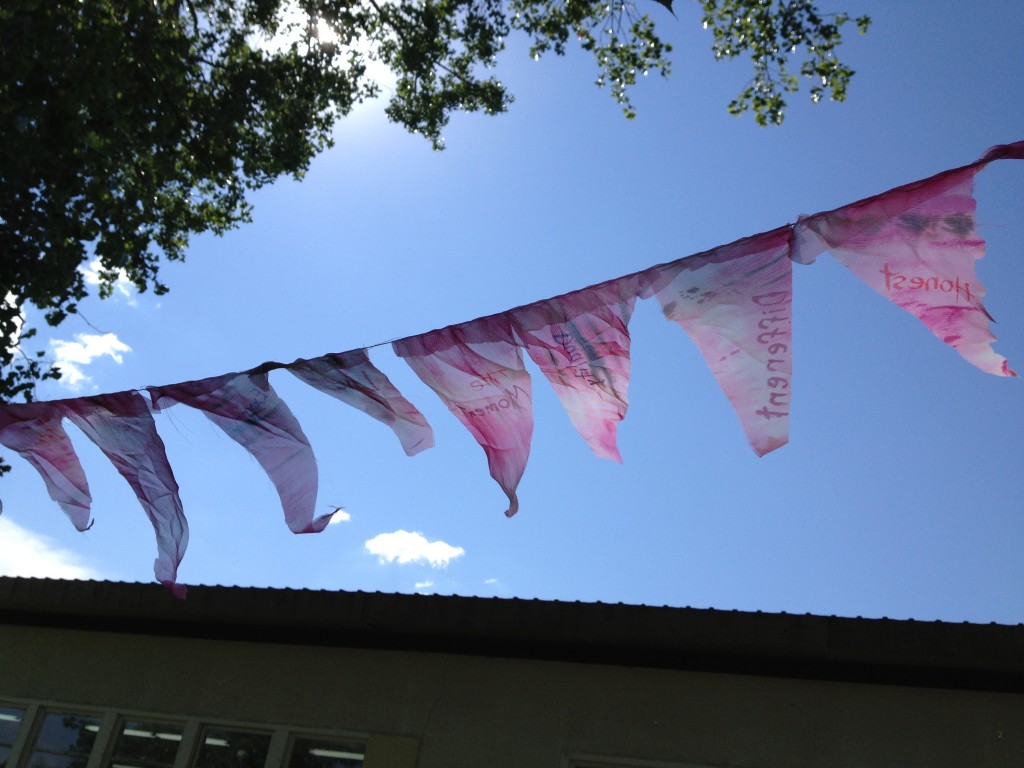
And with that, I end this part of my journey but continue on with the ongoing journey of my life, loving the people around me, living in the beauty that God is making of me, and serving the world with the gifts that have been entrusted to me with whatever time is left for me on this earth.
If you’re on a similar journey to a deeper place, and could use a guide to help you, consider signing up for one of my “Back to School” coaching sessions.
by Heather Plett | Aug 1, 2013 | Uncategorized
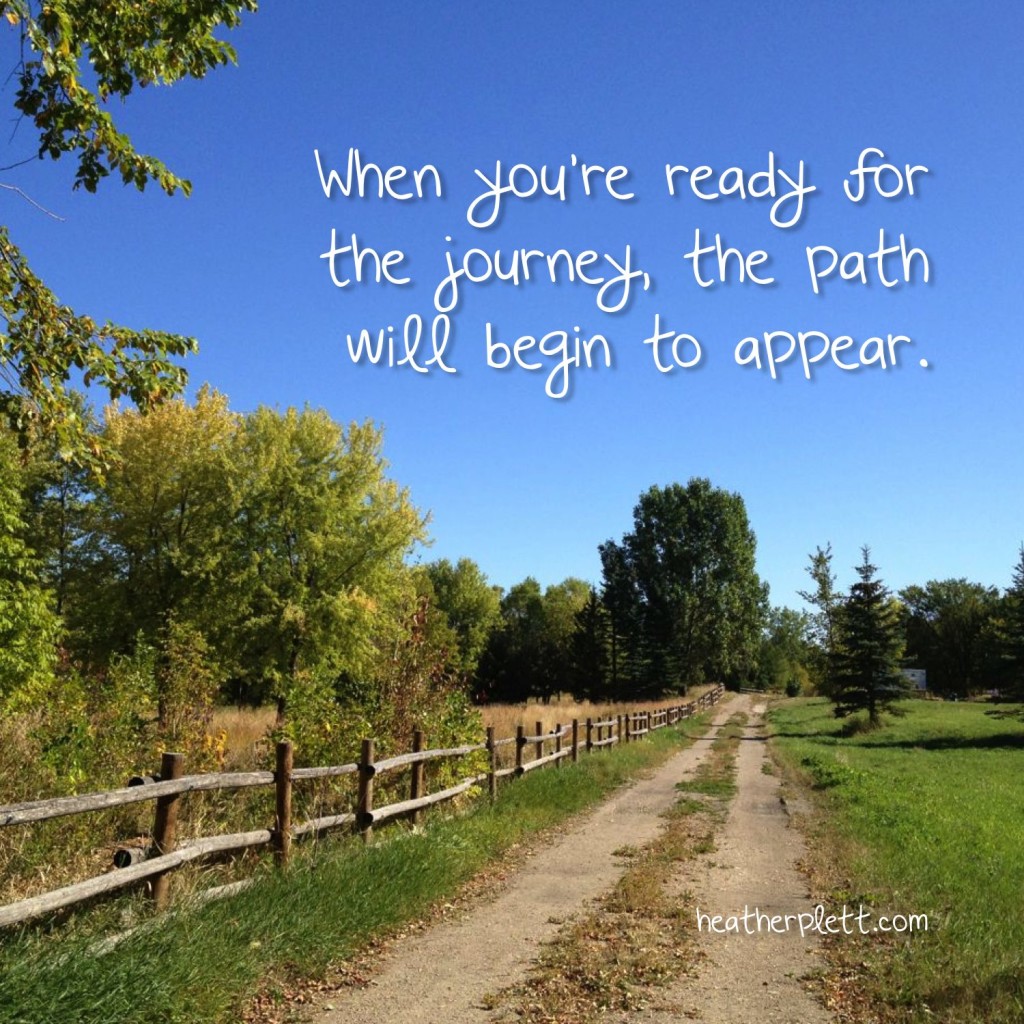 What do a human rights lawyer in Zimbabwe, a psychologist who’s a wealth management specialist in Los Angeles, a former pastor training to be an art therapist in rural Manitoba, and a manager in an international tech company in Chicago have in common?
What do a human rights lawyer in Zimbabwe, a psychologist who’s a wealth management specialist in Los Angeles, a former pastor training to be an art therapist in rural Manitoba, and a manager in an international tech company in Chicago have in common?
They’ve all gained something from my coaching.
What else do they have in common? They have a longing to make a difference in the world and to lead from a place of greater authenticity, deeper spirituality and more courage.
All three of these people (and all of my other clients) already had a great deal of wisdom long before they came into contact with me. They are lifelong learners, committed to doing good work in the world. They are strong, compassionate, and they have a lot of vision for how to make the world a better place. So… if they already had all these things, what did they need from me? They needed someone to ask the right questions and create the right environment to help them find their deeper truths, their authentic longings, and the next steps in their journeys. They needed clarity and support, and they needed someone who would challenge them to be the best versions of themselves.
That’s what I do for my clients – ask the right questions, create a safe environment, encourage them, and then nudge them into the places their hearts are already longing to take them.
My coaching work is not about creating something out of nothing – it’s about excavating the stories you already carry, the wisdom you might have buried under your own self-doubts, and the longing that has been waiting for you to give it space. It’s also about moving the blocks out of the way and challenging the stories that keep you small.
The deepening journey…
In Falling Upward, Richard Rohr talks about the deepening journey of the second half of life, when we leave the comforts of dualistic thinking (our black and white, rules-based world) and self-absorption, and move further into ambiguity, trust, and concern for the common good. This is a journey to our True Self, and it does not come without a struggle.
My coaching is about that journey to the True Self. I won’t take the struggle away, or make it easier to get to your True Self (because there is much to learn in the struggle and taking it away would not do you any favours), I’ll simply help you be more present, have more clarity, and take a more confident step onto the path.
In that journey to our True Self, you’ll begin to find yourself emerging into one of the leaders the world is longing for. I’ll help you understand what it means for you to be a leader.
“A leader is anyone willing to help, anyone who sees something that needs to change and takes the first steps to influence that situation.” – Margaret Wheatley
When I say that I coach leaders, it means that I coach anyone willing to help. Whether you lead from a place at the boardroom table, the kitchen table, or the garden bench, the world needs your willingness to help. You simply need to show up and hold your place in the circle.
If you are willing to help, but you’re afraid to call yourself a leader, I’d be happy to work with you.
Back to school…
September is back to school time, when we put away the flip-flops, clean out the backpacks, sharpen the pencils, and get ready for another year of learning, growth, and challenge. It’s a good time of year to commit to the new things that want to emerge in our lives. It’s a good time to consider what our next journey will look like.
September is also the time of harvest, when we gather the good things from our gardens, enjoy the feasts of Thanksgiving, and freeze and preserve what we’ll need for the long winter months.
Even if you’re not going back to school, September is a good month to invest in your own growth and learning, gather the fruits of your personal harvest, and contemplate the next steps in your journey. It’s a good time to invest in coaching for your own growth.
Invest in yourself…
This September, consider investing in yourself by working with me as your coach. To make that a little easier, I’m having a “back to school” sale.
Book a one-time coaching session for only $75. That’s 25% off the regular price.
Even better (because deep work takes time)… Book three sessions for $195. We’ll get really juicy in three sessions and I guarantee you’ll have a few a-ha moments in that time.
OR… sign up for the Fall session of Lead with Your Wild Heart, and take the journey in community with other learners. You’ll get the extra benefit of sharing in the stories of others who are also deepening in their leadership and self-discovery.
Back to School Sale ends August 23, 2013.
Note: I incorporate elements of a gift economy into my business model, and so I’ve created something called Karma Coaching. If you are doing important work in the world and believe that you would benefit from my coaching, I don’t want to let limited financial resources get in the way. Find out how you can benefit from the gift of my coaching, or participate in the gift economy by supporting other world-changers who want coaching.
by Heather Plett | Jun 17, 2013 | dreaming, journey, Uncategorized

I have a love/hate relationship with the word “intention”. I feel similarly about the word “manifest”. In the coach-y personal development world that some of my work fits into, people like to say things like “you have to set your intention in order to manifest your dreams”.
That kind of statement always makes me cringe a little.
The cringe comes from years of experience that has taught me that, despite what we want to believe, the universe is not an ATM machine that will spit out crisp, beautiful, unwrinkled dreams if only we punch in the right code. There is no simple magic – unless you’ve put something into the account, the ATM machine has nothing to pump out.
It also comes from the part of me that is fed up with the me, me, me culture we live in that I wrote about in my last post. We can’t expect our dreams to come true unless we are willing to invest in the collective dreams of our community.
In addition to those reservations, I also continue to believe that there is a God who orders the universe, and most of the time, we don’t get to see the big picture the way God does. There are times when we’re going to have to live through devastating disappointment – when our dreams come crashing at our feet – and we won’t understand the value in all of that heartache until we’re far into the future looking back in the rearview mirror.
All of that being said, I haven’t entirely given up on the word “intention”.
About ten years ago, I read a book about naming your personal mission and setting the direction you want to head in your life. At that time, I was employed in a government job that made me miserable and I was looking for some path out of it and into something more in line with who I am and what I’m passionate about. In the book was the suggestion that you should write out a “day in the life” journal page as though you are writing it five years in the future. The author of the book claimed that nearly everyone she knew who’d done that ended up almost exactly where they wanted to be.
I wrote my journal page, and you know what? The things I wrote about doing are almost exactly the things I spend my time doing now – teaching, hosting workshops, and writing. It took a few more than 5 years, but I landed where I’d hoped to land. The only part that didn’t come true was my wish for a house with a front porch and a porch swing. (I’m still holding out hope.)
There is definitely something about naming and owning your desires that helps you move in their direction.
So, despite my reservations, I still believe in intention-setting. I just believe in a little realism thrown in for good measure.
Here are a few of my thoughts on intention-setting:
- Your longings and passion are there for a reason. God gave you a desire to do the things that you love to do and it’s not selfish to want to do them. It’s only selfish if you keep them to yourself or if you do destructive things with them. Explore the deep longings in your heart and set an intention based on who you truly are and what you have to offer the world.
- Be prepared for a lot of detours on the path. Just because you set an intention doesn’t mean you’re going to get a straight path to its realization. Like I often tell clients, your journey is like a labyrinth. You always know that the centre is your destination, but sometimes you turn the corner and find yourself further from the destination than you were before. A few years after my journal-writing, for example, I found myself out of government and in a non-profit job that I loved, but that wasn’t quite where I expected to be. I learned a lot from that job though, so I have no regrets. Keep following the path and one day you’ll reach centre, though centre might not always look like you expected it to look.
- Hold your intentions lightly. Sometimes, on the path to making your dream come true, you’ll realize that there’s actually a bigger and better dream in store for you, or that you were dreaming the wrong dream, or that your dream is rather selfish. The things I teach in many of my workshops now are actually even more close to my heart than what I wrote about in the journal because I’ve done a whole lot of learning in the intervening years. Much of that learning came in the form of really tough lessons and disappointments. Be prepared to adjust your dreams or let some of them go.
- Even when you go through the dark night of the soul, trust that the light will return in the morning. In the past couple of years while I’ve been building my self-employment dream, there have been many, many times when it’s been so hard I’ve been tempted to give up. And yet there continues to be this driving force in me that hasn’t given up hope that I’m doing the right thing. It takes a lot of trust to get through the darkness, but once you’re through, you begin to realize the value in that dark path. I have learned, for example, that my work in the world is partly about helping people navigate in the dark. I couldn’t do that work unless I’d been in a few dark places myself.
- Be a gift-giver. Don’t make the realization of your dreams be solely about you and what you have to gain. Be a community-dreamer – set intentions for the collective good instead of your selfish good. Give your gifts to the community and be prepared to let your dreams change in the face of what your community needs. In my journal page dream, I was rather ego-focused, dreaming of the kinds of workshops I wanted to facilitate on my own. Since then, though, I’ve been immersed in the Art of Hosting and I realize that the work I now love to do, and the work that I believe will change the world, is more about co-hosting in circle and getting my own ego out of the way.

by Heather Plett | Jun 6, 2013 | Uncategorized
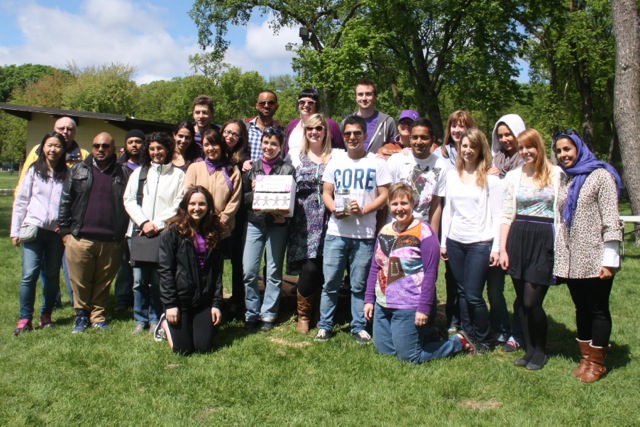
Standing in the park on Saturday, surrounded by my students after the Stand Up Super Games, I got a little choked up. I was immensely proud of this great group of students who’d pulled together, despite some of the rough spots they’d been through, to create a great event for a good cause.
Yes, the students had initiated the event because their assignment in the PR class I teach is to create some kind of PR campaign, but the energy they put into organizing it and fundraising for Osborne House showed that it had become so much more than an assignment; it had become a cause. Most of them showed up in that park not just because they wanted to pass the course, but because they cared for the women taking shelter at Osborne House due to domestic violence.
In showing up for a cause that they care about, my students were demonstrating that they are citizens of the world and they are doing their part in trying to make it better.
In his book, The Abundant Community, Peter Block talks about the difference between citizens and consumers.
“A citizen is one who is a participant in a democracy, regardless of their legal status. It is one who chooses to create the life, the neighbourhood, the world from their own gifts and the gifts of others. A consumer is one who has surrendered to others the power to provide what is essential for a full and satisfied life. This act of surrender goes by many names: client, patient, student, audience, fan, shopper.”
Sadly, there is a tendency in our culture to forget what it means to be citizens and to focus instead on our rights and entitlement as consumers. A recent news story about a man who refuses to mow the lawn on the boulevard in front of his home demonstrates that tendency. He believes it is “the city’s” responsibility to mow that piece of grass, forgetting that “the city” is each and every one of us who live here and that we all have responsibility to care for the place in which we live.
This man is not alone in his sense of entitlement and lack of commitment to the world around him. How often have you heard people complaining about the government, when they do very little to lobby the government for change and often don’t even vote? How often have we ignored the fact that our neighbours may be struggling with poverty or oppression because it’s “not our problem”? How many times do we ignore the damage being done to our earth because we assume we deserve the creature comforts that are produced from the earth’s limited resources?
As a friend living in Haiti reminded me on Facebook this morning when I ranted about this issue, this is the “tragedy of the full belly”. When we have too much, we expect too much. When we become self-reliant, we assume we don’t need other people and that they don’t need us. We stop contributing to our communities because we can get along just fine without them. And when we stop being community-minded, it becomes less and less important how our actions impact the people around us.
That’s why I got emotional when I was standing with my students in the park. In showing up for this campaign, they demonstrated that they haven’t forgotten about the need to contribute to their community. They’re willing to step out of their own comfort zones, forget about their own entitlements, and serve a cause that is bigger than them. This is what we need to foster more of in our schools and work places. This is leadership.
Meg Wheatley defines a leader as “anyone who is willing to show up and help”. Leaders, in other words, are those people who remember their citizenship and are willing to be part of a larger community. The students who contributed to the Stand Up Winnipeg campaign are willing to stand up and be leaders.
The more I do this work, the more I feel passionate about the need for us to stop being so focused on ourselves and our entitlements and start serving as citizens and stewards of the world. That’s why I’m so excited about the three upcoming events I’ll be co-hosting this summer.
On July 6, I’ll be in Ontario co-hosting Ignite: A day of retreat for women sparking change. On July 24, I’ll be in Winnipeg co-hosting The Art of Hosting and Harvesting Conversations that Matter. And then on August 1-4, I’ll be in Asheville, North Carolina, co-hosting Engage! A retreat for women with love in their hearts and fire in their veins.
All of these events are designed for people, like my students, who want to stand up and be counted, people who are willing to be citizens of the world, people who understand that communities thrive when each person shows up and makes a contribution.
These events are not about the old understanding of the leader as a hero, they are about a new understanding of the leader as a host. A host shows up and makes people feel comfortable. S/he engages people in meaningful conversation. S/he makes sure there is good food to eat. S/he is a steward of the place in which she lives. S/he builds community, not from the front of the room but from a place in the circle.
STAND UP now, and let’s make the world a better place.
 In the past week, I have done three interviews – two where I was guest speaker for online courses and one where I was a guest on an upcoming telesummit on feminine wisdom.
In the past week, I have done three interviews – two where I was guest speaker for online courses and one where I was a guest on an upcoming telesummit on feminine wisdom.











